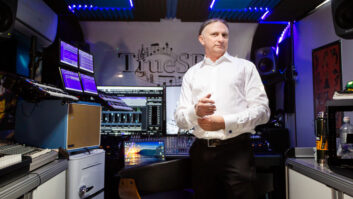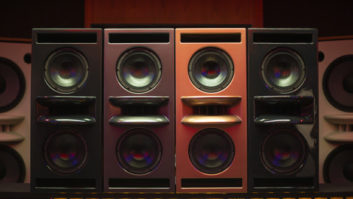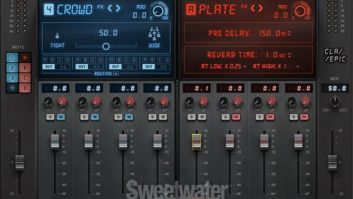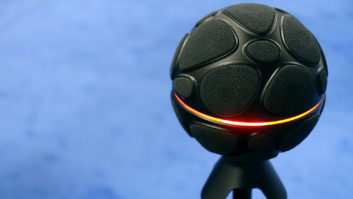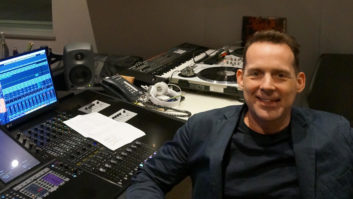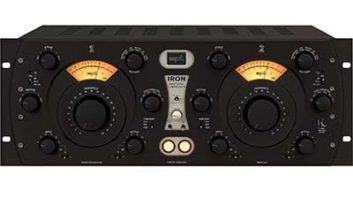Just as every stereo recording project is unique in some way, surround recording and mixing present certain variables and peculiarities. Recently, we looked at four very different surround projects: a hybrid stereo/surround classical recording; a pop album that was recorded by one engineer and mixed by another; the first 5.1 effort by a prominent artist and his engineer; and a tough surround remix of a classic rock ‘n’ roll film.
MAGNIFICENT MAHLER
It’s no secret that the classical music world has traditionally been a leader in embracing innovations in sound reproduction. “That makes sense,” says Telarc’s Jack Renner, one of the most respected engineers in his field. “Classical music has the widest dynamic range and greatest tone colors of any style of music. And it has a discriminating audience that wants to hear every nuance of the music.”
Not surprisingly, many classical music listeners and engineers seem to embrace surround with fewer reservations than some of their pop music counterparts. Telarc, a label known for its audiophile-quality recordings, has jumped into surround with both feet, releasing a number of excellent hybrid multichannel SACD/stereo recordings of classical music, jazz and blues. And the label is sufficiently committed to the format: Every CD booklet includes 10 pages about SACD and surround, including technical details, optimum listening environments, etc.
Renner says, “SACD is a wonderful way to give the listener an experience that’s much closer to a concert hall experience than we’ve ever been able to do in stereo because it’s so enveloping. Still,” he cautions, “understand that our approach is not one of circle-surround, where you put the listener right in the middle of the orchestra. In the good-old, bad-old days, I saw sessions — not Telarc’s — where the conductor was literally in the middle of the orchestra, and it was not a very good way to present classical music. So, we stay away from that. I’m still responsible to get the very best-sounding stereo product I can, because, at least initially, that’s the product most people are going to hear.”
Discussing last year’s magnificent SACD recording of Mahler’s big dark Symphony No. 6 in A Minor — the so-called “Tragic” symphony — Renner notes that whether he’s working on a stereo recording or in surround, his approach is similar, and it’s mostly about mic choices and placement. “In this case, at the Watford Coliseum, which is one of the best places to record classical music in London, I had [engineer] Tony Faulkner help me out. He provided the equipment, and we had five mics across the front of the orchestra, mostly tube Neumanns, eight or 10 feet in the air; the British standard is three meters, which is about nine-and-a-half feet. Then I had spot mics on winds, spot mics on timpanis, on the four harps, celeste, horns, percussion and on all these different things that have to come through in that piece. When things get heavy, the sound becomes rather thick and you’ve got to have help [from the spot mics].”
Aiding the surround image were two other sets of Schoeps mics: “The mids were about 12 feet from the orchestra; the rears about 15 feet,” Renner says. “On this particular recording, my mids were set as though you were going into the place and you put two mics up to try to make a believable stereo recording; it would not have quite the detail and the presence and the impact [of the mics across the front plus spot mics], but if you listened to it on its own, it would sound pretty good. It gives a nice overall spread, and it gives us the ability to pull the outer edges of the orchestra slightly around the listener. Then with the rear, you’ve got a seamless transition from the direct main mics to the mids to the rears. I had the rear mics pointing into the back corners to pick up the reflections for the surround [rears], but when we record in Cincinnati [where Telarc does a lot of work], I’ll point those rear mics directly at the ceiling. Other places I’ll point them are straight at the back wall; it depends on the venue.”
The recording chain consisted of the mics to various preamps (Millennia Media and Creation Audio) to DSD converters to a Genex 8500 DSD recorder. A DDA console was used as an interface only. No additional signal processing was used; purity was the watchword. Digital editing was done on a Sony Sonoma system.
“The stereo mix is mostly the main mics, plus some spot or helper mics, with a little bit of the room mics mixed in to add space,” Renner says. “The rear mics come in on the surround. We don’t try to come out of the session with the perfect finished surround mix. It’s one thing to try to mix stereo in control rooms that aren’t the greatest, but to have a surround mix, that’s tough. I’ll have a 5.1 system with us, but we don’t listen to surround all of the time. What I’m concerned with is getting good signal on all of the surround channels so that once we get back here [to Telarc], we’ve got plenty of options.”
Renner likes to keep his options open and still likes to experiment with different mics and techniques; recently, he cut a version of Handel’s “Water Music” with the Boston Baroque Orchestra using his regular setup, plus a Neumann stereo head set up right over the conductor’s head. “It turned out beautifully in surround,” he says. “But that wouldn’t have worked with the larger Mahler orchestra [117 pieces]. Every work is different.”
FAITHFUL TO BECK
One of the more sonically intriguing discs to come out during the past year was Beck’s Sea Change, which found the versatile singer-songwriter moving away from the big, brassy arrangements of his funky Midnite Vultures album toward a moodier, more stripped-down sound that is dominated by acoustic guitar, the occasional string section, and tasteful electric instruments and electronic sound treatments. The album was produced and engineered by Nigel Godrich; when it came time to create a surround version, Godrich was back in England working with Radiohead. At the recommendation of both Godrich and mastering engineer Bob Ludwig, Elliot Scheiner was brought in to mix.
“I was very flattered because I’m a huge fan of Nigel’s; I don’t think there’s a bigger fan,” Scheiner says from Presence Studios, the Connecticut facility where he does most of his surround work. “It’s such a beautiful record. Nigel is a real purist. The whole thing was done analog. And 95 percent of the record was live, done at Ocean Way, including strings. Even vocals were live. Nigel printed effects to tape. He made life so easy for me [as a mixer]. I think there were only one or two cases where I had to re-create effects. But really, with this album, I didn’t want to mess with Nigel’s or Beck’s vision in any way because it’s so great the way it is. My goal was to maintain the same sonic integrity that Nigel had when he mixed it originally.
“It’s funny; when I talked to Nigel, he said, ‘I didn’t put that much time into the mixes. They’re sort of like rough mixes off of the board.’ And I remember 25 years ago how we used to do that: You do a rough mix, you’re inspired for whatever reason at the moment, and an artist would say when you’re actually mixing, ‘Beat this!’ and you couldn’t. You don’t know what you did; it was just one of those things. These mixes were really outstanding. They were organic, recorded old-style — nothing digital about it. There are not many guys who are willing to make a record that way.
“In this case, with the surround, I just tried to convey that it was all live. So you don’t hear punches; you don’t get that feeling. There are no dead dropouts anywhere. There’s a constant flow on the record; you can hear that it’s live. And that’s not from me — [Nigel] did it in his mixes. There’s no muting going on. There’s no crap in between. It sounds like they went in the room and played the song, and then they were quiet at the end of the take.”
For the surround, Scheiner often put the orchestra in the rear speakers, “and I sometimes put some guitars in the rear; it depends on the track. The only thing that was dedicated to the front was the bass drum, Beck’s guitar and Beck’s voice. Then I’d try to envelop it by putting some of the drums — like the overheads — to the rear. Same thing with his guitar and vocal; the vocal was pretty much everywhere.”
He also spread effects around where possible. “A plate might be in mono,” he says, “but I opened it up a little bit and sent it to different speakers to make it bigger-sounding. Of course, you can’t make mono stereo. It is what it is. But you can play with the dimension of a sound by how and where you place it.”
Scheiner does not claim to have a format preference when it comes to mixing surround: “I don’t even consider what the formats are. I print to analog, so you can use whatever format you want when I’m done.” Nor does he have any set techniques: “Every record has its own set of rules, and you can’t necessarily go by what you did the last time out, except not to make certain kinds of mistakes. Obviously, it’s a little different if you engineered the record you’re mixing; you have more latitude.”
Still, he views his surround mix of Sea Change as one of his most satisfying projects in the medium thus far. “It’s just a wonderful record, and I must say, I’ve gotten more responses about this than any other surround project I’ve done. It seems to be having an enormous impact.”
MONTEREY POP REVISITED
Legendary engineer Eddie Kramer wasn’t at the Monterey Pop Festival back in June of ’67, but who better to work on the audio restoration and 5.1 mix of the classic D.A. Pennebaker documentary film for the recently released three-DVD Monterey Pop box set, which includes the movie, complete sets by Jimi Hendrix (Kramer was his principal studio engineer) and Otis Redding, and an entire disc of outtakes featuring everyone from Simon and Garfunkel to Quicksilver Messenger Service.
Kramer was limited with what he could do for the film’s surround mix because he had only seven audio tracks to work with (track 8 was a sync track), but he notes that his own aspirations for the project were not overly ambitious. “Basically, I just wanted people who watch the film to feel like they were there in the audience,” he says by phone from Metalworks Studios in Toronto, where he’s been toiling over another concert film, The Festival Express, featuring 1970 performances by Traffic, The Band, the Grateful Dead, Janis Joplin and others. “If you look at the actual physical layout of Monterey Pop [the Monterey Fairgrounds], it’s outdoors and there’s a stage and it opens up, and then there’s a little back wall that sort of encloses the place. So how do you get the feeling that the music is bouncing off of the back wall? What I did was, I created an artificial electronic reverb wall using the TC 6000 and the [Lexicon] 960, which is one of my favorite tools. I’ve come up with this method of utilizing both boxes and having them crisscross on the back wall.
“As for the audience track, well, you only have one mono track to work with, so you have to use leakage and delays and whatever you can to spread out that track and make it sound like it’s coming from the sides and the back. Also, the other effect I was going for was to make the music sound like it’s coming off of the P.A., that it’s actually traveling a distance. Again, that’s something you can simulate with reverbs and delays.”
Kramer did his work on Monterey Pop at NRG in Los Angeles while working on a vintage Neve console in several media. “I started by making a one-to-one 15 ips Dolby SR copy with SMPTE code and then recorded on Pro Tools and also on [Tascam] MX-2424. I try to use analog EQ and analog compression; analog everything until the point where it actually has to leave the analog and get into the digital world. I use Mytek converters — I love those — and we used the Rosendahl wordclock to keep everything perfectly aligned. It can be a little bit of a nightmare getting it all lined up.”
The original tracks were recorded by Wally Heider, and although the tapes were well-preserved, Kramer says that using a Cedar system on certain noisy tracks proved to be invaluable: “Without it, there were some tracks that would have been unusable. The decrackling program in Cedar was amazing, and we managed to salvage a lot of stuff, particularly in the Otis Redding material, where there was a bad cable that affected some of the drum tracks.”
Kramer also did a surround mix for the recent DVD of Jimi Hendrix’s final performance at the Isle of Wight in 1970, which begs the question: Would he like to go in and remix Hendrix’s studio albums in 5.1? “Well, the first two albums were 4-track, so I’m not sure about those, but I’d love to go in and do Electric Ladyland. That would be something. I think that will happen.”
AN OLD DOG’S NEW TRICK
This past December, Graham Nash was the unlikely recipient of the Surround Music Awards’ Artist of the Year trophy for his fine 2002 solo album, Songs for Survivors. We say “unlikely” only because it was the first surround outing for both Nash and for engineer and co-producer Nathaniel Kunkel. “It was really a thrill to win that award,” Kunkel says. “And Graham deserves it because, more than anyone else I’ve worked with, he really threw away all of his preconceived ideas about surround. He didn’t compare it to stereo albums. He embraced it fully for what it is.”
Songs for Survivors was unusual in that it was released in surround (by DTS) before it came out in stereo (on the Artemis label). However, Kunkel originally mixed the record in stereo (at Conway in L.A.); later, after DTS showed interest in the project, they went back and did the 5.1 at Nash’s Kazoo Studio in Kauai, Hawaii, and at Kunkel’s own Studio Without Walls in Santa Monica, Calif. Both facilities are equipped with Sony DMX-R100 consoles and identical Pro Tools setups. “What was cool,” Kunkel says, “is we could take an AIT tape back and forth from Hawaii to my place; the other great thing is I have a hunk of hard drive space at apple.com, and since he has a full 5.1 playback system with DTS decoders, I could do a mix for him, encode it onto a DTS audio disc, rip it and put it on my hard drive. He has high-speed Internet access in Hawaii, and in two hours, he could be listening to a DTS disc.
“My only real rule for the 5.1 mix was to make it feel good,” Kunkel continues. “If something felt good in the back, I’d put it into the back. If it felt like it should be kind of spread out over four speakers, I did that. If the bass sounded better in every speaker, I did that.
“The first song we mixed was ‘The Chelsea Hotel,’ and we did it very quickly. We just sort of threw it up and spread everything around to see how it sounded. We did it in about two hours, and we printed it, and I was never able to beat it. That actually made it onto the record, but that turned out to be the easiest. Other songs took much more time, of course.”
The album was cut mostly live in the studio, and Kunkel found that when he went in to make the 5.1 mix, he became even more conscious than usual of the relationships between the instruments in the songs’ arrangements and how the band balanced itself from moment to moment. “The musicians were really playing together, and the nuances of how they respond to each other as the track is going down became much more apparent as you spread the track out in 5.1,” he comments. “So as I spread it out, things started to blossom: I became aware of little moments that happened and movements that the musicians themselves were making happen, where they would naturally transition in a way that made a cool left-to-right sound and that suggested certain things for the 5.1.
“But every track was different. On ‘Come With Me,’ Graham is in the front with this harmonica in the middle and this guitar in stereo. But in the surround, the melodica is in the left rear, the banjo is in the right rear, and the drums are dead-center in the middle of the room. On other tracks, I put the drum ambiences in the rear, or I’ll pull the overheads more like 3 o’clock and 9 o’clock. I’ll even put a vocal there on occasion.
“I just mixed an Insane Clown Posse record for DTS, and I broke every rule there is for 5.1,” Kunkel adds with a laugh. “Everything that could move, I made move; every gimmick I could pull out of my bag of tricks, I did. In fact, you’re dying for more! We were a little more conservative with Graham’s record, but it’s still really interesting.”
Blair Jackson is the senior editor of Mix.
